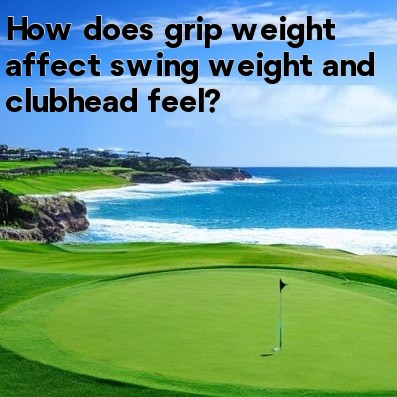
In golf, how does grip weight affect swing weight and clubhead feel?
Golfers often underestimate the importance of grip weight when it comes to their swing and the overall feel of their clubs. The grip weight has a direct impact on the swing weight and clubhead feel, influencing the performance and playability of the golf clubs. Let's dive deeper into this topic.
When we talk about swing weight, we are referring to the distribution of weight throughout the golf club, specifically the balance point. Swing weight is measured on a scale from A to F, with A being the lightest and F the heaviest. The swing weight affects the club's ability to feel light or heavy during the swing, which can impact a golfer's timing and tempo.
The grip weight plays a significant role in determining the swing weight of a golf club. Adding weight to the grip increases the club's swing weight, making it feel heavier throughout the swing. Conversely, reducing grip weight will result in a lighter swing weight.
But how does the swing weight affect the overall feel of the clubhead? The swing weight distribution has a direct impact on the club's balance and the golfer's ability to control the clubhead during the swing. A higher swing weight can help golfers who prefer a slower tempo, as it allows them to maintain better control throughout the swing. On the other hand, a lower swing weight can be beneficial for those who prefer a faster tempo, enabling them to generate more clubhead speed.
The grip weight also influences the feel of the clubhead throughout the swing. A heavier grip can make the clubhead feel more stable and connected to the golfer's hands, resulting in a more solid and controlled swing. Conversely, a lighter grip can create a sense of increased clubhead speed and a more effortless swing.
It's essential to strike the right balance when it comes to grip weight, swing weight, and clubhead feel. A grip that is too heavy or too light can lead to inconsistencies in the swing and affect shot accuracy and distance. Golfers should experiment with different grip weights to find the optimal balance that suits their swing style and preferences.
- To increase grip weight and swing weight, golfers can opt for heavier grips or add additional grip materials such as lead tape or tungsten plugs.
- Conversely, to reduce grip weight and swing weight, golfers can choose lighter grips or trim down the grip size.
- It's worth noting that making changes to the grip weight may require adjustments in other areas of the club, such as adding or removing weight from the clubhead or adjusting the shaft length.
A golfer's individual preferences and swing characteristics will ultimately dictate the ideal grip weight and swing weight combination. Working with a club fitting professional or a qualified instructor can greatly assist in finding the perfect setup for optimal performance and feel on the golf course.
In conclusion, grip weight plays a significant role in influencing the swing weight and clubhead feel. By understanding the relationship between grip weight, swing weight, and clubhead feel, golfers can make informed decisions about their equipment and make adjustments that enhance their swing and overall performance.





